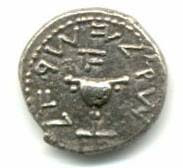

Obverse: Head of Domitian facing right
Inscription: Caesar Avg F Domitianus Cos Des II
Reverse: Victory facing right placing a laurel on a Roman legionary standard
Inscription: Victoria Avgvsti
Domitian is not making a donkey of himself, this bronze coin is known as an As.
An As, a bronze coin, was worth 1/10th of a silver denarius. Due to inflation, the As was struck relatively infrequently, disappearing from circulation and finally being completely dropped from usage in the 3rd century AD.
This particular coin was struck in 72-73 AD, and it can be dated quite precisely as the coin notes that it was struck when Domitian had been Designated a Consul for a second time (COS DES II), which occurred in 72 CE. At the time Domitian was a Caesar under the Emperor Vespasian, his father.
It is part of the Jewish War Victory Coinage series struck after the Roman victory in the First Jewish War. On the reverse of the coin, the goddess Victory is decorating a legionary standard with a laurel, a symbol of victory.
As for Domitian, he became Emperor after the death of his brother Titus, who had succeeded Vespasian. Domitian is the last of Suetonius' The Twelve Caesars . Suetonius, writing in the age of Nerva finished his racy and interesting chronicle with the death of Domitian. Domitian ruled for 15 years, finally being assassinated in a palace conspiracy and he was replaced as Emperor by Nerva. Domitian suffered the damnatio memoriae, or the removal of references to him in public records, the melting down of his coinage and the defacement and removal of his image in public artwork.
This was my first ancient Roman coin purchase back in 1990, and it marked the end of my modern coin collecting habit and the start of years into the study and collecting of ancient coinage.
As an interesting aside, the British Museum Catalog number for this coin is BMC II p.144, *, meaning that it is in the second volume of the British Museum Catalog, which is an excellent reference for Roman Coins as the British Museum has one of the finest collections anywhere. However, the * in the catalog number means they lack an example of this coin in their collection, so I have at least one coin that they lack.

No comments:
Post a Comment